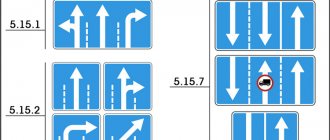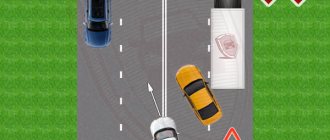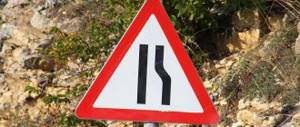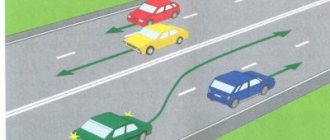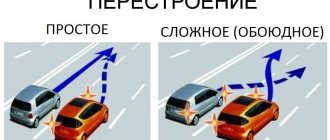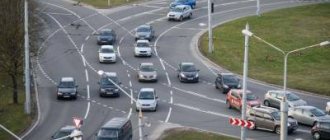In large cities, traffic intensity is extremely high, so accidents occur quite often. One of the most common types of accidents that occur in heavy traffic conditions is a lane change accident. Since changing lanes is one of the most difficult maneuvers that requires increased attention and concentration on the part of the driver, if the person driving the vehicle does not show enough care during maneuvering, an accident will become inevitable. In this case, all affected parties need to collect all possible data regarding the accident to help traffic police officers identify the culprit of the violation.
How the maneuver is performed
When changing lanes, the driver must take into account the following rules:
- First of all, you need to pay attention to the movement of other vehicles. Before changing lanes, you must let all cars moving on the right pass.
- When changing lanes, a motorist must give way to those vehicles that do not plan to change lanes.
- When changing lanes, the motorist must turn on the turn signal. In this way he will notify other traffic participants about the planned actions.
Most lane change accidents happen for two reasons:
- the driver did not let other cars pass;
- The driver did not turn on the turn signal before performing the maneuver.
When driving in general traffic flow, the task of each motorist is to control the situation on the road. It is very important to pay attention to the movement of other drivers, promptly responding to changes in the situation. If required, one motorist must give priority to the other.
How to behave in case of an accident
Every driver must clearly know the procedure for his actions in the event of an accident, regardless of whether he is the culprit of the violation or the injured party. If an accident occurs on the road, then the participant, in accordance with paragraph 2.5. Traffic rules must do the following:
- turn on the hazard warning lights on the car, if it is equipped with one, and also install an emergency sign. Depending on where the accident occurred, the requirements for the distance at which it must be placed in relation to the collision site vary. So, in urban areas the sign should be installed at a distance of 15 meters from the collision site, and outside the city - 30 meters. If an accident occurs behind a blind corner, then a sign is placed in front of it to provide advance warning to other road users about an unpleasant situation on the road;
- all participants in the accident, as well as their vehicles, must remain at the scene of the collision until the traffic police inspectors arrive. If the cars of the participants in the collision block the passage and create difficulties for the movement of other vehicles, then they can be removed from the roadway if only property was damaged during the accident. However, most auto experts recommend not to rush to remove cars from the scene of an accident, but to first dial the police hotline and get advice from the traffic police officer on duty regarding the possibility of removing the vehicle from the roadway;
- If a decision is made to remove vehicles from the road, the driver must record the position of the vehicles involved in the incident. This must be done in writing, as well as by recording it on a photo or video camera, with the involvement of witnesses to the accident itself;
- in the event that there are injured citizens as a result of a car collision, they must be provided with primary assistance, as well as call an ambulance to the scene;
- It is also necessary to ask witnesses of the accident who cannot remain at the scene of the accident for a long time to leave their contact information. In this case, the traffic police representatives who arrived at the scene of the accident will be able to contact witnesses, if necessary, to obtain additional clarification regarding the accident, and quickly determine the culprit of the collision. If there were no witnesses at the scene of the incident, and there are residential buildings or a shopping center in the adjacent area, you can walk around the area and try to determine if there are people there who could have witnessed the accident;
- dial the traffic police and report the event itself and the location of the incident;
- If, as a result of a collision during a lane change, there are no injured persons, only two cars were involved in the accident itself, and the participants agree on the culprit of the accident, then drivers have the right to limit themselves to drawing up a Europrotocol , without calling traffic police representatives to the scene of the accident.
You should also be advised to remain calm and reasonable. You also need to remember that when changing lanes, priority right of movement is given to cars that are moving along the traffic lane, as well as to those vehicles that notified traffic participants in advance about the planned maneuver by turning on the turn signal.
Overview of Common Violations
Let's look at some of the most common violations that drivers commit when changing lanes:
- When changing lanes, the motorist does not keep his distance. Such actions most often end in a collision.
- Noticing an obstacle in his lane, the driver begins to abruptly change lanes. This does not turn on the turn signals, and therefore other road users do not have time to react to the changed situation in a timely manner.
- Changing lanes is carried out in a traffic jam. As soon as a seat becomes available in the next row, the driver tries to take it, ahead of other motorists. Naturally, wanting to “slip through”, he does not give any light signals, which leads to a collision. This situation is not uncommon.
- The driver does not pay attention to the actions of other motorists. Having turned on the turn signal, he must make sure that other cars allow him to pass. Otherwise, a serious accident may occur.
Accident while changing lanes
Changing the car to the right lane
First, let's look at the simplest situation:
Obviously, if the cars are positioned this way during a collision, then the driver of the orange car , who did not give way to a car moving without changing direction (clause 8.6 of the traffic rules was violated).
Note. Even if the driver of the white car is intoxicated, the driver of the orange car will still be found guilty, because violation of clause 8.6 occurs in any case. In the described situation, the driver of the white car will be deprived of his license, but he will not automatically become guilty of the accident.
Changing lanes at the same time
Let's consider another popular road accident, where identifying the culprit does not cause any particular problems:
the orange will be at fault .
Don't forget that when changing lanes on multi-lane roads, you should look not only at the cars in the next lane, but also at the cars driving across the row. This will avoid simultaneous rebuilding and associated problems.
Please note that in the examples discussed above, the cars are located at an angle to the edge of the roadway, so identifying a car changing lanes is quite easy.
In practice, a car may change lanes slowly (almost parallel to the edge of the roadway), and in this case, difficulties may arise in determining the culprit of the accident.
Changing lanes to the right at a slight angle
Consider the following example:
Here the orange car is driving almost parallel to the edge of the roadway, and it can be determined that it is changing lanes only by the presence of road markings. While the car is above the broken line, it is in the process of changing lanes.
In this case the orange car is to blame for the accident, but if there were no markings on the road, the traffic police could have found the driver of any of the cars guilty.
The car was completely rebuilt before the collision
In the picture above, the orange car is within the right lane, so the driver of the white car will most likely be found to be at fault for the accident. Nevertheless, he still has a chance to prove his innocence.
Learning how to change lanes correctly
At first glance, this maneuver does not pose any particular difficulties. However, in practice, there are a number of nuances that must be observed in order to avoid getting into an accident. When changing lanes, the driver must follow the following algorithm:
- First of all, you need to assess the situation on the road. A vehicle changing lanes must not interfere with the movement of other vehicles. To do this, you need to look around and in the rearview mirrors. You should also make sure that there are no potholes on the road that would prevent you from changing lanes.
- Before the maneuver, you must turn on the turn signal, notifying other drivers of the planned actions.
- You should change lanes smoothly, without sudden jerks to the sides, which can end in failure. At the same time, the driver must monitor the actions of other motorists.
Accident when changing lane to the right lane
A traffic accident that occurred when a motorist was changing lanes to the right lane deserves special attention. In accordance with the norms of Russian legislation, in this case the driver who was moving in the left lane will be found to be at fault for the accident.
According to the traffic rules, the motorist had to make sure that drivers driving on the right side gave him the opportunity to perform this maneuver.
Even if alcohol is found in the blood of the driver driving on the right side, the driver driving on the left side will still be found to be at fault for the accident. However, a motorist who was driving a vehicle while intoxicated will also be held accountable for violating this traffic rule.
How to file a traffic accident
Changing lanes incorrectly most often results in a collision with another vehicle. In this case, the motorist must know the rules for registering an accident.
By default, an accident is registered by a traffic police inspector. However, motorists can draw up a European protocol without involving traffic police officers in this process. To do this, the following conditions must be met:
- two vehicles were involved in the accident;
- As a result of the collision, only cars were damaged;
- drivers have no disagreements regarding who is at fault for the accident;
- damage from the accident does not exceed 50 thousand rubles;
- both motorists have MTPL policies (if you have CASCO insurance, you must call traffic police inspectors).
Responsibility for incorrect lane change
Having committed this offense, the driver may receive one of the following penalties:
- a fine of 500 rubles;
- deprivation of driver's license for up to 12 months.
Consequences of an accident when changing lanes to the left
Accidents when changing lanes to the left occur much less frequently, but also have their own rather impressive statistics.
In accordance with traffic rules, the culprit of such an accident is the driver who changed lanes. Before performing the maneuver, the driver had to make sure that it was safe to perform.
Regardless of the condition of the second driver, the motorist who changed lanes will be considered responsible for the accident.
In accordance with the traffic rules, a person who was found to be at fault for a traffic accident is obliged to compensate for material damage that was caused to the owner of the second vehicle.
If the person at fault for the accident has a compulsory motor liability insurance policy, the responsibility for compensating the damage caused to the victim rests with his insurance company.
How to avoid being the culprit of an accident when changing lanes?
Based on the examples discussed above, you have learned to identify the culprit of an accident when changing lanes in a given situation. However, it would be a good idea to consider a few tips that will help you avoid being the culprit of an accident:
- In heavy traffic, always stay on the right side of the selected lane.
- In any case, stay within “your” lane, even if it forces you to sit in traffic a little longer.
Let's look at each of these points in more detail.
1. You should occupy the right side of the selected lane . This will allow you to solve 2 problems:
- If they change lanes from the left into “your” lane and “force” you to “start changing lanes” (drive over the marking line between the lanes), the driver of the car on the left will still be at fault.
- If you change lanes on the right, then you will have enough space to move a little within the lane and not cross the markings. Naturally, you should return to the right side of the lane as soon as possible.
In addition, driving on the right side of the leftmost lane will allow you to keep a sufficient distance from the oncoming lane and not accidentally drive into it.
2. cross the marking line dividing adjacent lanes if you really want to change lanes.
If the road situation is such that you can freely drive forward, but to do this you need to cross a solid marking line with one wheel, then it’s better not to do this. As practice shows, if you move into the adjacent lane just a little bit, in most cases you will not be able to return to your lane. And therefore, for a long time your car will be in a “state of rebuilding”, which should not be allowed.
If you learn to constantly follow these simple rules, then even if an accident occurs, you will have an excellent chance of having your car repaired at the expense of the second party to the accident.
Well, in conclusion, I suggest you watch a funny video about an accident involving a foreign car and a VAZ 2107:
Driving a car is unthinkable without changing lanes; if the driver does not comply with traffic rules and is reckless, then this maneuver can lead to various accidents.
Types of accidents during lane changes. Who is to blame in each of the typical cases?
Features of such accidents:
- Such accidents are typical for populated areas with heavy traffic and are often associated with insufficient professionalism of drivers.
- The second feature is that in collisions the cars receive minimal damage.
Emergency situations:
- In an accident when changing lanes from the left lane to the right, the driver from the left lane will be considered the culprit of the accident, since he had to let vehicles pass in the direction of travel in the right lane. Let us note that even if the driver from the right lane is intoxicated, he will be deprived of his license, but the culprit of the accident, according to the rules, will be the one who initiated the dangerous emergency situation, i.e. made the wrong lane change.
- Collision while changing lanes at the same time. In this case, the culprit will again be a car from the left lane. To safely change the position of a car on a multi-lane road, you need to pay attention not only to the adjacent lane, but also to the one behind it. Since there may be situations when two cars plan to change lanes at once, but in the end they may not share it.
- In an accident when changing lanes to the left, the culprit will be the car changing lanes, since before the maneuver it must allow traffic in the direction of travel and not violate road safety.
- In road accidents when changing lanes at the same time, difficulties often arise in determining the culprit. For example, there was a traffic jam and two cars decided to change lanes at the same time. In an ideal situation, there is enough space on the lane for two and both cars can change lanes simultaneously at the same speed and at the same angle, but this does not happen in practice. This results in a collision, and the culprit will be the one who in fact does not keep the distance, the speed limit, or does not indicate his intentions with turn signals.
- An accident on a multi-lane road is complicated by the fact that the actual number of cars moving along its width may exceed the number indicated by the markings. Sometimes 5 motorists can squeeze onto a 3-lane roadway at the same time. This is due to the heavy traffic load on the roads. At the same time, there are a large number of cars that are constantly in a position to change lanes. In such cases, it is quite difficult to determine the culprit of the accident on your own. The presence of a DVR will provide significant assistance in this regard for both drivers and traffic police officers.
- In an accident when changing lanes at an intersection, the vehicle changing lanes will most often be to blame. Although this maneuver at an intersection is not prohibited by the rules, however, the intersection is one of the most dangerous sections of the road. Therefore, firstly, you need to occupy the lane along which you need to move further in advance, and secondly, you must follow all other rules for changing lanes. It is better to waste time by waiting than to understand the circumstances of the collision.
Important! Even if all the rules are followed, the vehicle that is most often found guilty of an accident is the one that did not have time to fully enter the traffic lane.
